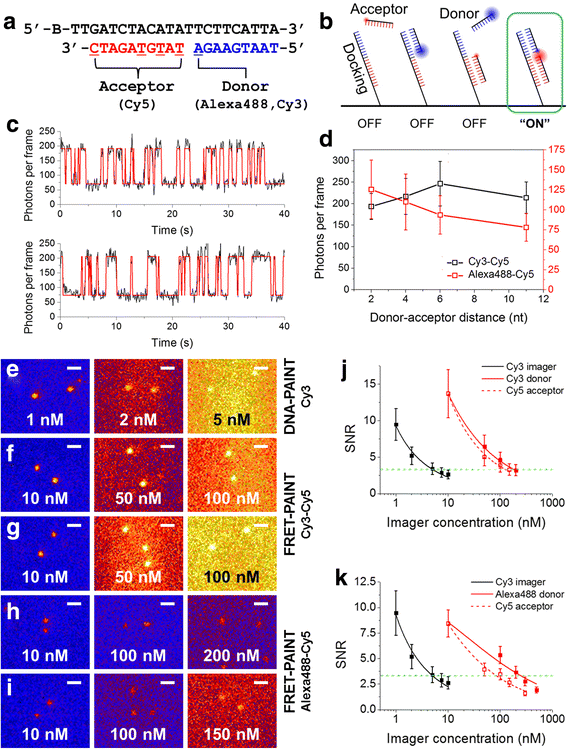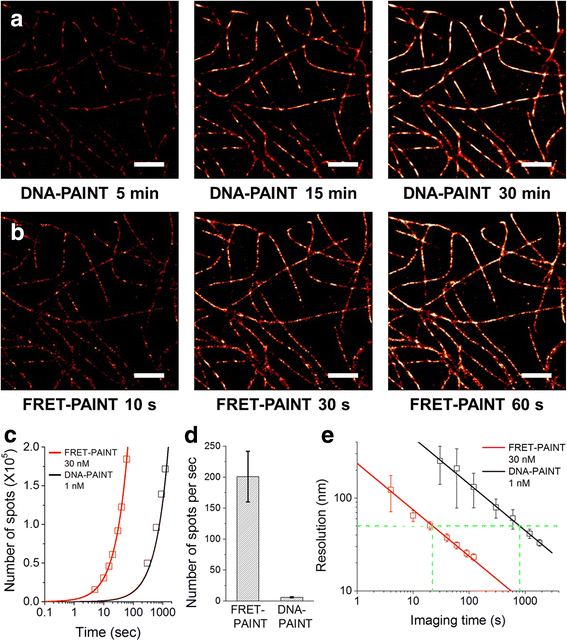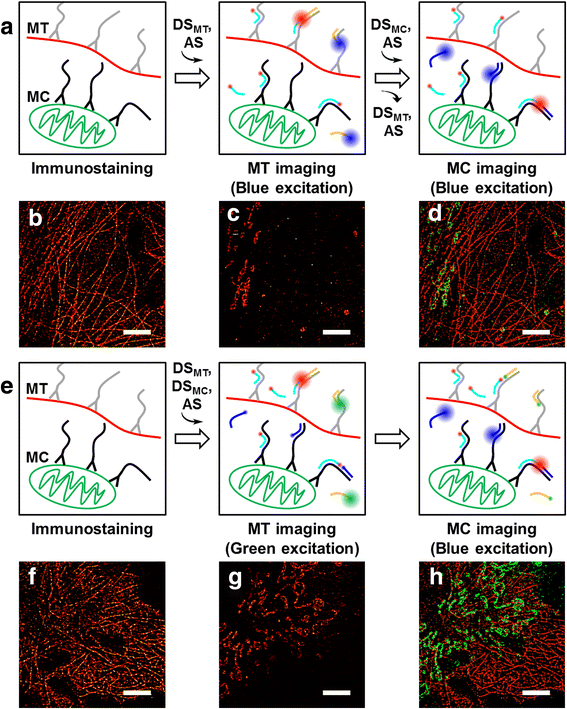Accelerated super-resolution imaging with FRET-PAINT
- PMID: 29284498
- PMCID: PMC5747120
- DOI: 10.1186/s13041-017-0344-5
Accelerated super-resolution imaging with FRET-PAINT
Abstract
Super-resolution fluorescence microscopy in the current form is hard to be used to image the neural connectivity of thick tissue samples due to problems such as slow imaging speed, severe photobleaching of fluorescent probes, and high background noise. Recently developed DNA-PAINT solved the photobleaching problem, but its imaging speed is extremely low. We report accelerated super-resolution fluorescence microscopy named FRET-PAINT. Compared to conventional DNA-PAINT, the imaging speed of the microscopy increases up to ~30-fold. As demonstrations, we show that 25-50 second imaging time is long enough to provide super-resolution reconstruction of microtubules and mitochondria of COS-7 cells.
Keywords: DNA-PAINT; FRET; FRET-PAINT; SMLM; fluorescence resonance energy transfer; single-molecule localization microscopy; super-resolution microscopy.
Conflict of interest statement
Ethics approval and consent to participate
Not applicable.
Consent for publication
Not applicable.
Competing interests
The authors declare that they have no competing interests
Publisher’s Note
Springer Nature remains neutral with regard to jurisdictional claims in published maps and institutional affiliations.
Figures



Similar articles
-
Accelerated FRET-PAINT microscopy.Mol Brain. 2018 Nov 22;11(1):70. doi: 10.1186/s13041-018-0414-3. Mol Brain. 2018. PMID: 30466455 Free PMC article.
-
Fast, Background-Free DNA-PAINT Imaging Using FRET-Based Probes.Nano Lett. 2017 Oct 11;17(10):6428-6434. doi: 10.1021/acs.nanolett.7b03425. Epub 2017 Sep 21. Nano Lett. 2017. PMID: 28871786
-
Correlative Single-Molecule FRET and DNA-PAINT Imaging.Nano Lett. 2018 Jul 11;18(7):4626-4630. doi: 10.1021/acs.nanolett.8b02185. Epub 2018 Jun 29. Nano Lett. 2018. PMID: 29943993
-
DNA-Based Super-Resolution Microscopy: DNA-PAINT.Genes (Basel). 2018 Dec 11;9(12):621. doi: 10.3390/genes9120621. Genes (Basel). 2018. PMID: 30544986 Free PMC article. Review.
-
About samples, giving examples: Optimized Single Molecule Localization Microscopy.Methods. 2020 Mar 1;174:100-114. doi: 10.1016/j.ymeth.2019.05.008. Epub 2019 May 10. Methods. 2020. PMID: 31078795 Review.
Cited by
-
DNA hybridisation kinetics using single-molecule fluorescence imaging.Essays Biochem. 2021 Apr 16;65(1):27-36. doi: 10.1042/EBC20200040. Essays Biochem. 2021. PMID: 33491734 Free PMC article. Review.
-
Quantifying molecular- to cellular-level forces in living cells.J Phys D Appl Phys. 2021 Dec 2;54(48):483001. doi: 10.1088/1361-6463/ac2170. Epub 2021 Sep 9. J Phys D Appl Phys. 2021. PMID: 34866655 Free PMC article.
-
Fluorogenic DNA-PAINT for faster, low-background super-resolution imaging.Nat Methods. 2022 May;19(5):554-559. doi: 10.1038/s41592-022-01464-9. Epub 2022 May 2. Nat Methods. 2022. PMID: 35501386 Free PMC article.
-
Multipair Förster Resonance Energy Transfer via Spectrally Resolved Single-Molecule Detection.J Phys Chem B. 2022 Aug 11;126(31):5765-5771. doi: 10.1021/acs.jpcb.2c03249. Epub 2022 Jul 27. J Phys Chem B. 2022. PMID: 35897122 Free PMC article.
-
Fluorescence nanoscopy at the sub-10 nm scale.Biophys Rev. 2021 Dec 2;13(6):1101-1112. doi: 10.1007/s12551-021-00864-z. eCollection 2021 Dec. Biophys Rev. 2021. PMID: 35059030 Free PMC article. Review.
References
-
- Hell SW, Kroug M. Ground-state-depletion fluorscence microscopy: A concept for breaking the diffraction resolution limit. Appl. Phys. B. 1995;60:495–497. doi: 10.1007/BF01081333. - DOI
Publication types
MeSH terms
Grants and funding
LinkOut - more resources
Full Text Sources
Other Literature Sources
Research Materials

